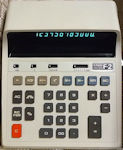
|
AKA: ELECTRONIC CALCULATOR, F-2, AKA (Label): F-2, Product number (P/N): F2 (F-2),
Keywords/Tags: F2 (F-2)
Date of intro: 1977, Origin: Japan (List), Dimensions: 240x190x62mm, Weight: 860g,
Power: 3V: (D x2), Adaptor: CASIO_adaptors: AD4160,
Display: Type = Display (VFD) (List), Digits = 12+1,
Number of keys: 29, #Key-Blue: 4, #Key-Grey: 24, #Key-Orange: 1,
Keyboard Array (Rows x Columns): 05x08,
Decimal switch: [6-4-3-2-1-0-ADD2], Round switch: [F-CUT-5/4-UP], Miscellaneous switch: [(Blank)-ITEM
(Blank)-K],
Classification: / Desktop with Display,
Featuring: Procent, Square root, Logic-technology: VLSI (Very Large Scale Integration), calculator-on-a-Chip, Memories: 1,
Related with: CASIO_docu: M4000938L (Cat.); CASIO_docu: (Cat.) 198402: Electronic Calculators; CASIO_docu: (PriceList) *: (19780710 Direct Dealers); CASIO_docu: (Broch.) *: The calculators that make... (F1,F2); CASIO_docu: (Cat.) 198102 (Japanese); CASIO_parts: (Box) F2,
Main Components: HITACHI: HD38401A,
Serie-members: CASIO: F1 (); CASIO: F2 (),
Initial Cost Price: 16�800 JPY (€ 136,08), Collector value: 7/10,
Info: DUDEK Emil:
Power:
3V DC using 2 x 1.5V D sized batteries. It accepts an adaptor (AD-4160G, 3V [or perhaps 6V] 2.8W, centre negative) through a socket on the top edge, to the far right.
Display:
12+symbol blue VFD: the symbols (to the far left) are used for memory, error and negative indication.
Features:
Standard four functions with selectable floating/fixed decimal modes, switched rounding modes, switched constant, four function memory, register exchange, percentages and delta percent, square root,
change sign, entry count, hundreds entry and delete.
Semi-RPN logic.
Comments:
A sturdy, medium-sized desktop from the later 70s which has a few extra useful functions. My example is not working so cannot comment on the logic.
I am mystified why a DC adaptor should need a bridge rectifier and large heat-sink power transistor.
Case and Design:
Two-piece construction made from matt light cream plastic, which has organic/futuristic flowing lines. A heavily inset and almost vertical green plastic display filter gives a bright and high contrast display.
An additional black plastic plate sits proud in its own recess with silver printed lettering for the brand and model number.
Keys and Switches:
The keys in orange, light grey, dark grey, grey and blue are rather randomly grouped and uneven in appearance.
They are medium travel with a soft clunk on pressing and return. A metallic panel sits in its own recess and is printed with black text for the switch labels.
Construction:
Remove the two screws from the rear. There are then two side lugs to be popped (by pushing in the front section) and two lugs on the top edge, that easily release by hinging.
The rear can then be hinged off to the left. The inside area of the case has two molded matrix tables for keyboard layouts labelled GX-3.6 and GX-5.
Boards: The whole calculator assembly is attached to the front section: the keyboard assembly by four screws and metal brackets, the main board, face down, by a single metal bracket.
The two are joined by a 26-way ribbon cable. Main board reference A10V-1A J2-E GCMK-19EHB. There is an earthed metal screen panel on the rear of the case.
Components:
TBD 1 x CPU: HITACHI HD38401A 0L 45 (date code November 1980) 36 pin DIL, 0.6" width black plastic.
1x 12 digit + symbol green VFD display, single tube flat glass face NEC FIP13A10/LD8214 0M (December 1980)
1x bridge rectifier, 3x transistors (one 2SA715 with large heat sink), 14x diodes, 14x capacitors, 6x resistors, 1x voltage converter unit: CT0604
Internet: Link-1: CASIO CALCULATOR COLLECTORS
|
| Item |



















